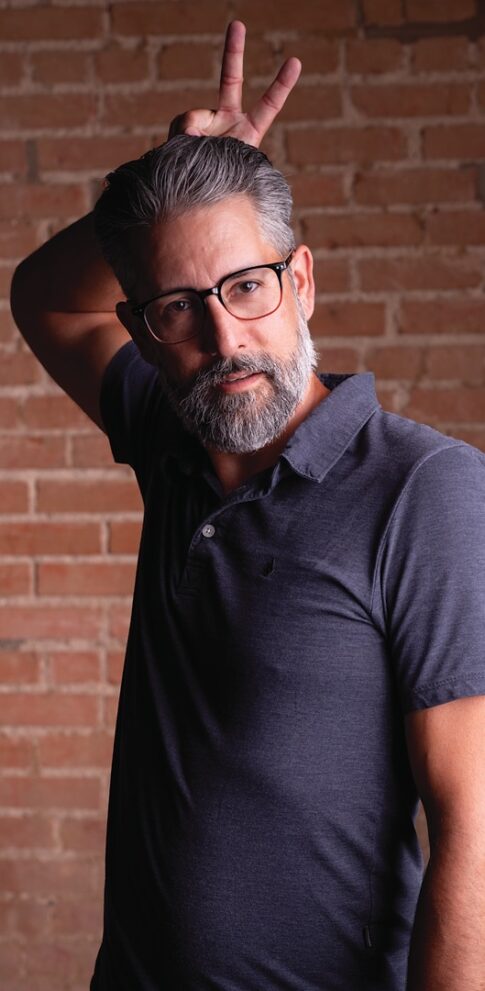
BY Taylor Adams Cogan
It’s often the case that a pastor hopes to guide and teach, shaping beliefs and offering a path forward.
But try that in Deep Ellum, and the neighborhood just might change the pastor instead.
That was the case for Joel Triska, who came to Deep Ellum in 2009 carrying the conservative theology of his upbringing and seminary education. He and Rachel were voted in as pastors at Life in Deep Ellum (LIDE) in June of that year – just as the neighborhood was beginning to stir awake again from a downward side of its regular cycle.
“At the time, Deep Ellum was a ghost town,” according to Joel. “You could park anywhere, whenever you wanted. There was no Cane Rosso. What we had was Twisted Root, Angry Dog, and St. Pete’s. Lemongrass was still on Elm. Trees hadn’t reopened yet. Dada was there, but it was a very different environment.”
LIDE was housed in a former nightclub on Taylor Street that had been converted into a church and cultural center by a previous group.
“We developed a relationship with the founder of that community. In 2008 and 2009, they were in transition. The leader at the time, Tony, resigned, and we were in the process of stepping into leadership,” Joel says.
Stepping into this transition for both the community and the church, Joel had already been in ministry for years and had earned a master’s degree in divinity, but this new role brought a slow and unexpected transformation.
“I came from a very conservative background, and so did the community. But over the 12 years I served at LIDE, I changed a lot of my views based on hundreds of conversations with people in Deep Ellum. People didn’t really trust me unless I had a beer with them,” he said. “I used to tell pastors who came to visit and try to learn from us: Deep Ellum discipled me.”
In those early years, Triska became more embedded in the life of the neighborhood, sitting on boards like the Deep Ellum Foundation and Deep Ellum Community Association, learning the civic and economic forces that help shape the district.
“I was on the Foundation board during some points of tension, trying to bring together new folks and older property owners who had perspectives that, in my opinion and in others’, led to the economic bubble popping,” he said. “Leasing out to shady businesses, increased crime, and really hurt the perception of Deep Ellum. Dallas saw it as a dangerous place until probably the mid-2010s.”
His theology evolved alongside his understanding of urban design, civic engagement, and social justice.
“Whether it was boycotting DART’s plans to split the neighborhood in half with the D2 rail, or sitting in meetings after Scott Rohrman came in with 42 Real Estate and handed out The Death and Life of Great American Cities by Jane Jacobs – we were schooling ourselves.”
The original vision for LIDE, he says, had a more standard evangelical bent.
“I let go of that in graduate school. That model tends to be imperial: persuade others to see things your way,” he says. What Rachel and I tried to advocate for was something different: not a savior complex, but integration. Supporting the best parts of what was already here.”
That led to LIDE’s four pillars: art, music, commerce, and community.
“We did what we could with our resources, hosting concerts, renting out the building, sitting in on all kinds of conversations. But eventually we had to ask ourselves: Is throwing events what we’re really about?” he says.
As Deep Ellum filled in – Trees and Dada reopened, The Factory gained momentum, for example – LIDE’s role shifted.
“We didn’t need to fill in the gaps anymore,” he says. “Our role became more about being a voice of conscience. What does it mean to create safety in the neighborhood without marginalizing our unhoused people?”
A number of Joel’s conversations happened at Deep Ellum Brewing, just a few steps away from LIDE. When the taproom closed, Joel was one of many who felt that loss deeply.
“I wrote a lot of sermons in that space. It made me sad when it shut down,” he says. “Now I’ve found another home at Westlake with Art. But it’s kind of a Twilight Zone walking around there these days,” noting that he’s not in the neighborhood as much as he used to be.
He still thinks often about what it means for Deep Ellum to grow and change without forgetting where it started.
“To really grow, we have to stay tethered to the origin story,” Joel says. “For me, that means never fully getting rid of the grit. It’s part of the DNA. If the grit disappears, Deep Ellum disappears.”
These days, Joel works in leadership development at Southwest Airlines, but he hasn’t lost sight of what LIDE meant.
“It played a really pivotal role in the regeneration of the neighborhood,” he says. “Sean Fitzgerald, Tanner Hockensmith – they were heavily involved before I got there. Stephanie [Keller Hudiburg] took over leadership later, but when she came on, a lot of the hard work had already been done. It created a blank slate to build on. What we had to do was remove some of the old-school mentalities that didn’t know how to collaborate with the private sector.”
Today, LIDE is evolving in its own way. But, Joel says Life in Deep Ellum was never supposed to be about the pastors.
“It was a commune of people. It was Mokah. It was our parking lot – the largest free one in Deep Ellum for a long time. And that icon out front, holding the umbrella: that’s what I hope the legacy is,” he says. “When Deep Ellum was a ghost town, LIDE was there, raking the hardened ground to produce fruit.”
